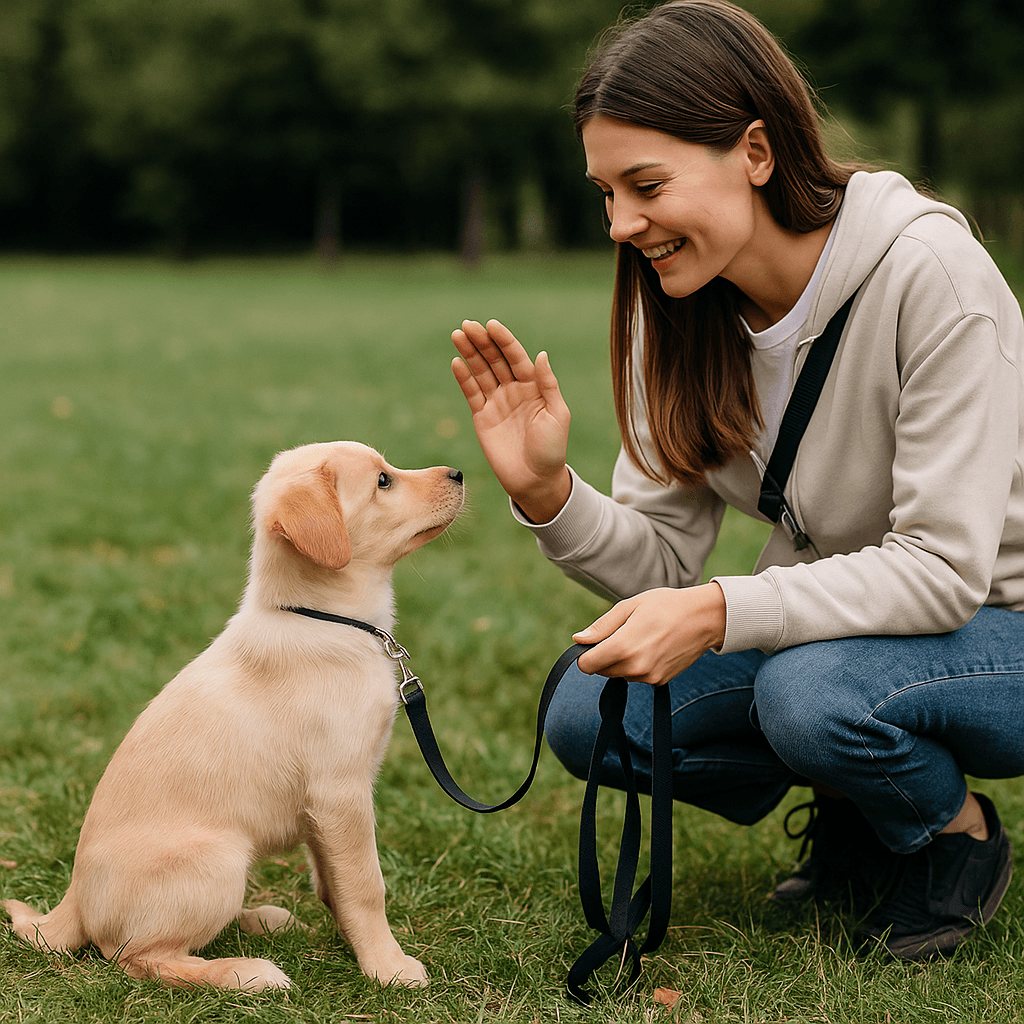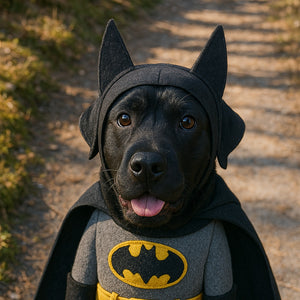
Is your dog pulling on the leash and ignoring your calls? Learn effective ways to get the perfect walk.
Walking your dog is more than just a chore – it's a key element of everyday life with your pet. It's a moment of closeness, exploring the world together, and building relationships. However, for a walk to be safe, comfortable, and enjoyable, your dog should know the basic rules: walking on a loose leash, returning when called, and not posing a threat to themselves or others. In this article, you'll learn how to teach your dog these skills step by step, why they're worth introducing, and how to maintain a good walking culture.
Why is it worth teaching your dog to walk on a leash and to recall?
Many owners dream of their dog walking calmly alongside them, without pulling, and coming when called, even in the presence of other dogs. This is possible, but it requires patience, consistency, and good communication. Proper leash walking and reliable recall:
- increase the dog's safety,
- improve the comfort of walking,
- reduce stress for the caregiver and the animal,
- build trust and control,
- make life easier in public spaces.
It's also the foundation for further activities and training – from agility to city walks or mountain hikes. A well-behaved dog is not only comfortable for its owner – it also provides greater safety for those around it . 🔗 American Kennel Club (AKC) – How to Train Your Dog to Walk on a Leash
Step by Step: Learning to Walk on a Leash
1. Start at home
Before heading outside, let your dog become familiar with the leash and harness in a calm, familiar environment. Practice walking around the house – reward him when he walks at your heel, doesn't pull, and maintains eye contact.
2. Establish a loose leash policy
Never move forward if your dog is pulling. Stop or turn in a different direction. Reward your dog only when the leash is slack. Teach him that only a calm walk allows him to move forward.
3. Frequent changes of direction
Walk your dog in different directions—randomly turning, stopping, and changing your pace. This teaches your dog to focus on you and reduces pulling.
4. Use rewards
In the initial phase of training, it's a good idea to have treats your dog loves on hand. Reward him for eye contact, heeling, and calm behavior.
5. Enter the command
Choose a command, such as "heel" or "close," and say it consistently as your dog walks alongside you. Pair the word with a hand movement or visual cue.
6. Practice in different places
Once you've mastered leash walking in the house or garden, move your training to the streets, parks, or even the city. Your dog must learn to ignore distractions.

Step by Step: Learning to Recall
1. Build positive associations
Never call your dog only when playtime is over—this teaches him to avoid the command. Also call him in neutral situations to receive a reward and return to playtime.
2. Command and Enthusiasm
Use the command "come!", "come!", or another word of your choice. Call your dog cheerfully, enthusiastically, and in an encouraging tone of voice. Reward generously.
3. Don't punish after cancellation
If your dog has done something wrong, don't punish him after he returns—even if it takes a while. This is to associate his return with something positive.
4. Use a training rope
Initially, it's a good idea to practice recall on a long line (e.g., 5–10 meters). This provides control and safety without the risk of escape.
5. Practice in different conditions
Practice recall in various locations: a park, a meadow, or the beach. Gradually increase the difficulty level: the presence of dogs, people, and noises.
6. Turn yourself into a "prize"
Become more curious than everything around you. Change directions, hide behind a tree, crouch – surprise your dog so he'll eagerly seek out your presence.

Dog training stages – age-appropriate
Puppy
- Train in short sessions, full of rewards.
- Focus on building positive associations.
- Teach "in a relaxed way" – without punishment, with a lot of fun.
Adult dog
- Work on consistency and routine.
- Reinforce appeal throughout life.
- Introduce exercises in new environments.
Senior
- Adjust the length of walks to your dog's abilities.
- Use a leash with a soft grip.
- Provide more breaks, comfort and warmth.
Common problems and how to solve them
The dog is attracted to other dogs
- Keep your distance – don't get too close at first.
- Practice focusing on yourself using the “look” command.
- Reward for ignoring dogs from a distance.
- Avoid direct confrontations on narrow paths.
The dog gets excited about cyclists or runners
- Teach the command "leave it" or "don't touch it."
- Increase your distance – practice next to bike paths with controlled exposure.
- Strengthen your focus on yourself with games and treats.
The dog doesn't want to go any further
- Check if he is tired, overheated or stressed.
- Vary your walking routes to avoid boredom.
- Use a “step reward” – reward for every step forward you take.
Walking as a therapeutic tool
Walking can be therapeutic not only physically but also emotionally. Especially for dogs with trauma, separation anxiety, or sensory oversensitivity, routine and predictable walks help with:
- lowering the level of cortisol (stress hormone),
- building trust in the caregiver,
- learning self-control and response to stimuli.
What helps?
- Quiet neighborhood, few stimuli.
- Walks at fixed times.
- A common ritual: the same equipment, the same commands, a gentle voice.
Walking with more than one dog
How to start?
- Start with separate walks to learn each dog's walking style.
- Practice focusing and loose-leash walking separately.
- Introduce going out together gradually – first with another person as support.
Tips:
- Use different colored leashes to easily distinguish between dogs.
- Keep it in order: one on the left, one on the right.
- Use collective commands (“let’s go”, “stop”) and individual commands (“Leo, heel”, “Luna, sit”).
Socialization and socialization walks – the key to a calm and confident dog
Socialization is the process by which a dog learns to function in the world of people and animals. It's not just about getting used to the presence of other dogs, but also to stimuli such as city noise, children, bicycles, and new smells. Proper socialization takes place primarily in the first few months of a dog's life, but it's important to continue it throughout its life.
What is a socialization walk?
A socialization walk is a controlled encounter with other dogs and people, taking place in a safe environment, usually under the supervision of an experienced trainer. The goal of such a walk is not to entertain, but to teach your dog to interact neutrally with other dogs.
Why are socialization walks important?
- They teach the dog to be calm and ignore other dogs in public spaces,
- They help anxious or reactive dogs gain self-confidence,
- They reduce the risk of conflicts in the future,
- They make it easier to learn to walk on a leash in the presence of distractions,
- They build positive associations with the presence of people and animals.
What should a good socialization walk look like?
- Small group (3–6 dogs) – to maintain control and avoid overstimulation.
- Division of dogs according to temperament – e.g. young, reactive, calm.
- Maintain a constant distance between dogs – avoid accidental contact.
- Dogs on training leashes (3–5 m) – for comfort and safety.
- The presence of caregivers who focus the dogs' attention on themselves – not on other dogs.
- Gradually shorten the distance if the dogs remain calm .
When to start socializing your dog?
Socialization should begin as early as possible – from 8 weeks of age (as long as the puppy is healthy and has had its first vaccinations). This stage is crucial for the dog's emotional and behavioral development. However, older dogs can (and should) also undergo secondary socialization – for example, after adoption, after a bad experience, or after a long period of isolation.
The most common mistakes during socialization:
- Exposing the dog to stressful situations too quickly and intensively,
- Lack of support from the owner – the dog must know that it can count on you,
- Allowing uncontrolled contact with strange dogs (especially on a leash),
- Forcing your dog to interact – socialization is not forced play.
Home socialization – what to pay attention to?
- Get your dog used to sounds like: vacuum cleaner, TV, doorbell,
- Introduce different surfaces: tiles, grass, sand, stairs,
- Show your dog new objects: umbrella, bicycle, stroller,
- Introduce guests – but make sure your dog can retreat,
- Work on calmness – teach your dog that nothing bad happens when something new is present.
Socialization walk and the dog park
Dog parks can be risky – dogs aren't always under control, and they may be pushy, sick, or aggressive. It's important to remember that contact with other dogs isn't mandatory, and that a socialization walk isn't a playground.
Where to look for socialization walks?
🔗 American Veterinary Society of Animal Behavior – Position Statement on Puppy Socialization
- Dog schools and dog kindergartens,
- Facebook groups and local dog-loving communities,
- Trainers and behaviorists leading thematic walks,
- Shelters organizing integration walks for adopted dogs.
Well-conducted socialization is a lifelong investment. It helps create a dog that is confident, emotionally stable, and socially capable. A socialization walk can be part of your routine—even once a week makes a huge difference.
The Psychology of a Dog on a Walk
For your dog, walking allows him to explore, gather information, and build a sense of security. Remember that:
- every scent is a message – let your dog sniff around,
- some dogs become overstimulated more quickly – give them space and time,
- Walking too fast or too much stimuli can lead to frustration and over-reactivity.
A good walk is one after which your dog returns home calm and fulfilled, not just physically tired.
Walking culture – golden rules
- Always keep your dog under control – a leash or reliable recall is a must.
- Don't let anyone run up to you - even a "friendly" dog can scare someone.
- Clean up after your dog – it's a matter of culture and law.
- Respect the space of others – not every dog enjoys contact with others.
- Avoid “crowded” places – your dog has the right to a quiet space.
- Adjust the route and length of the walk to your dog's needs – not every dog needs to walk 5 km a day.
Checklist for a good walk – what is worth taking?
- ✅ A leash and a well-fitting harness or collar
- ✅ Poop bags
- ✅ Water and a foldable bowl (especially in summer)
- ✅ Your dog's favorite treats as a reward
- ✅ Training rope (if you are training recall)
- ✅ Towel or blanket (e.g. PETTO) – if you plan to stop
- ✅ Raincoat or dog coat – in case of bad weather
Good walking practices in the city and in nature
In the city:
- Use a short leash (1.5–2 m) so that your dog does not disturb passers-by.
- Practice passing people and other dogs – while keeping your distance.
- Only use city dog areas if your dog feels comfortable there.
- Do not allow your dog to sniff people or enter stores without invitation.
In nature:
- Only use a long leash or let your dog loose where it is legal and safe to do so.
- Take care of nature – do not let your dog chase wild animals.
- Respect other walkers, cyclists and runners.
- Make sure the dog has a current identification tag (tag, chip).
Real-life examples – success stories
Luna – a fearful dog
Luna, a dog adopted from a shelter, was afraid to leave the stairwell for months. Regular walks in a quiet neighborhood, always at the same time, using a guard harness and a 3-meter leash, helped her regain her confidence.
Leo – an energetic Labrador
Leo pulled so hard on the leash that his owner began avoiding walks. Only after implementing scent training, frequent changes of direction, and working with a trainer did Leo learn to walk on a loose leash and focus on his owner.
Product support from PETTO
In the PETTO store you will find products that support training and the comfort of walks:
- 👉 Dog leashes and harnesses
- 👉 PETTO steps – comfortable support for your dog
- 👉 PETTO car seats – for safe and peaceful journeys
Summary
Learning to walk on a leash, respond to a recall, and behave politely in public spaces isn't a whim—it's the foundation of a life spent with a dog. Any dog, regardless of age or temperament, can learn these skills if we approach training with patience and respect.
Walking isn't just physical activity—it's an opportunity to communicate, build relationships, and explore the world. Let's teach our dogs not only to respond to commands but also to function in society with empathy and calm. With the right approach and support, every walk can become a favorite moment of the day—for both you and your pet.
🐾 PETTO – because everyday life with a dog can be beautiful, peaceful and safe.
See more at: Petto.com.pl




































 https://petto.com.pl
https://petto.com.pl